OnePlus 6 vs. Galaxy S9: This Couldn't Be Closer
OnePlus has produced yet another bargain in the OnePlus 6, with tons of performance for hundreds less than competitors. But is the OnePlus 6 better than the Galaxy S9+?
OnePlus has been around only since late 2013, but in less than five years, the company has carved out a niche selling flagship-caliber phones for bargain prices.
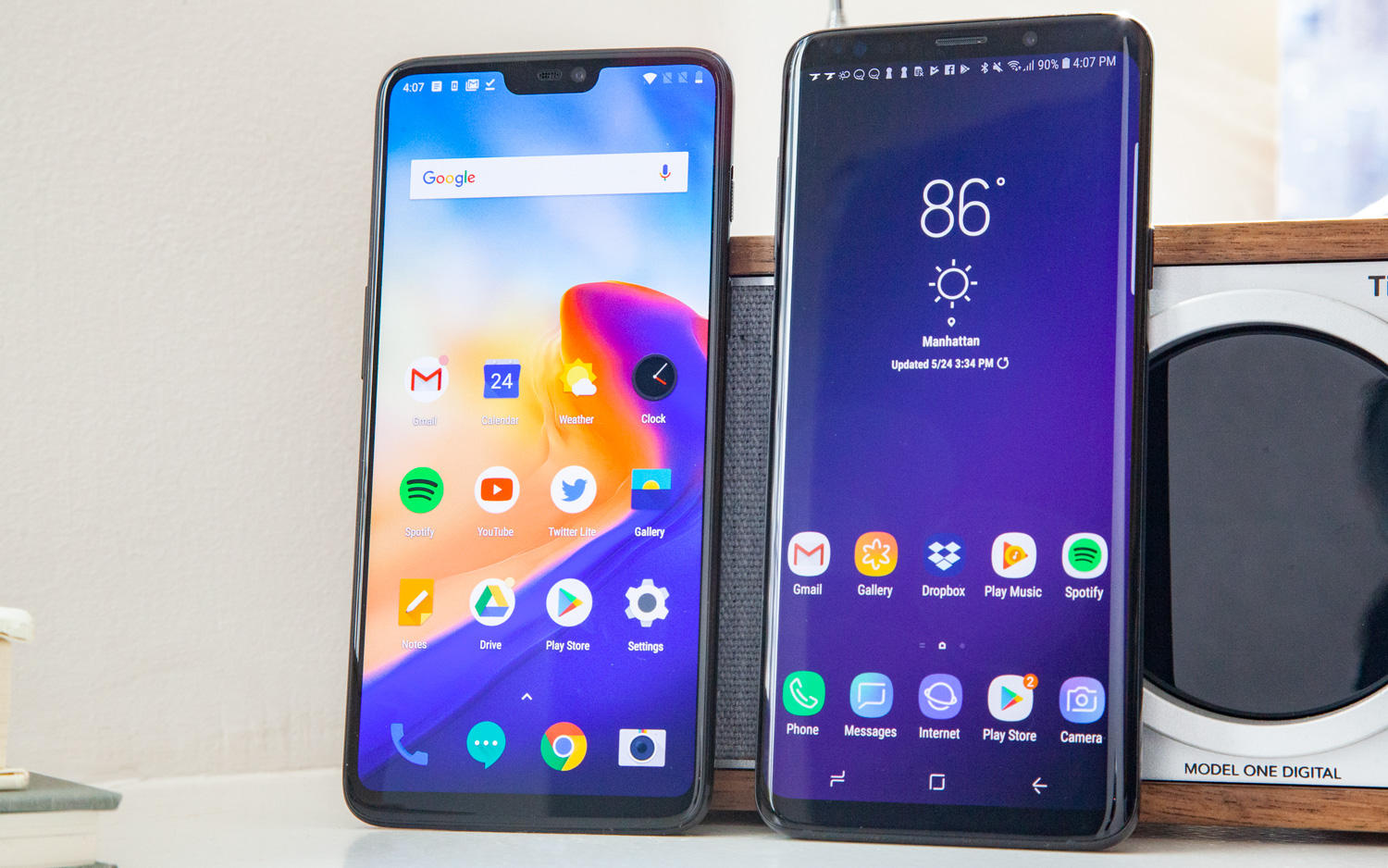
Its latest effort, the OnePlus 6, offers Snapdragon 845 power, dual cameras and an AMOLED display, all for roughly $300 less than the similarly featured Samsung Galaxy S9+. But given that big of a gap in price, some customers might be wonder where the catch is with OnePlus' phone. What exactly do you miss out on by going with the cheaper device? What, if anything, do you gain?
To find out, we've pitted the Galaxy S9+ against the OnePlus 6 in this head-to-head comparison.
OnePlus 6 and Samsung Galaxy S9+ Specs
| Phone | OnePlus 6 | Galaxy S9+ |
| Price | $529/$579/$629 | $839/$889/$959 |
| OS | Android 8.1 Oreo with OxygenOS | Android 8.0 Nougat with Samsung Experience 9.0 |
| Screen Size (Resolution) | 6.28-inch AMOLED (2280 x 1080) | 6.2-inch AMOLED (2960 x 1440) |
| Processor | Snapdragon 845 | Snapdragon 845 |
| RAM | 6GB/8GB | 6GB |
| Storage | 64GB/128GB/256GB | 64GB/128GB/256GB |
| microSD Slot | No | Yes |
| Rear Camera | Dual: 16 MP (f/1.7) with OIS; 20 MP (f/1.7) | Dual: 12 MP (f/2.4 or f/1.5) with OIS; 12 MP (f/2.4) with OIS |
| Front Camera | 16 MP (f/2.0) | 8 MP (f/1.7) |
| Battery Size | 3,300 mAh | 3,500 mAh |
| Battery Life | 10:33 | 10:59 |
| Water Resistance | No | Yes |
| Size | 6.13 x 2.97 x 0.30 inches | 6.22 x 2.91 x 0.33 inches |
Design
The OnePlus 6 resembles a mishmash of various cues from flagship phones in 2018. You've got your iPhone X-style notch up top, thin bezels all around, a back made of Gorilla Glass 5 that doesn't really look like glass, and an extra-tall 19:9 AMOLED display front and center.
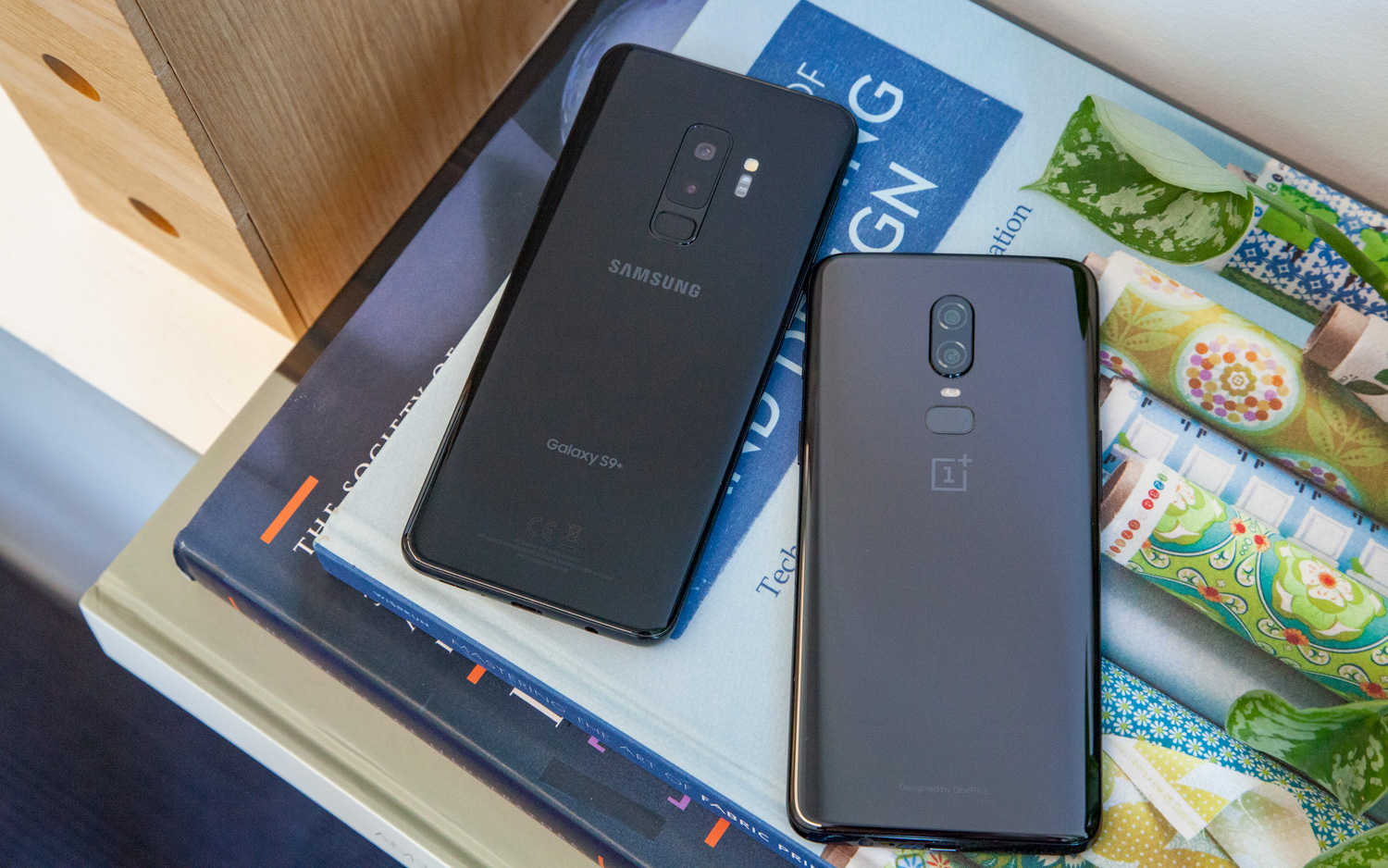
There's no knocking OnePlus' build quality or use of materials here. Our Mirror Black OnePlus 6 has the sheen of ceramic and feels sturdy despite the transition away from the aluminum used in last year's OnePlus 5T. But the new phone is also large and unwieldy, and ergonomically, it can't match the compactness and one-hand usability of the Galaxy S9's Infinity Display.
Dimensionally, the Galaxy S9+ is technically the larger phone. But because of those curved sides, it doesn't feel like it. Samsung's latest flagship may not have changed a whole lot from its predecessor, but the company struck a winning formula with the Galaxy S8, and this is one of those instances in which you don't fix what isn't broken.
On each phone, you'll find a headphone jack along the bottom edge opposite a bottom-firing speaker. In the Galaxy S9's case, this is one of two speakers, with the second located in the earpiece. The OnePlus 6 doesn't have a stereo setup, nor does it have IP-certified water resistance or wireless charging.
Get instant access to breaking news, the hottest reviews, great deals and helpful tips.
Ultimately, there's a lot to like about the OnePlus 6's fit and finish, but it just lacks the comfort of use and feature set that makes the Galaxy S9 so universally appealing.
Winner: Galaxy S9+
Display
As it turns out, Samsung produces the AMOLED panels used in both the Galaxy S9+ and OnePlus 6. Therefore, it came as little surprise to find they compare quite favorably in terms of color gamut and accuracy, though the S9+ bears one notable advantage.
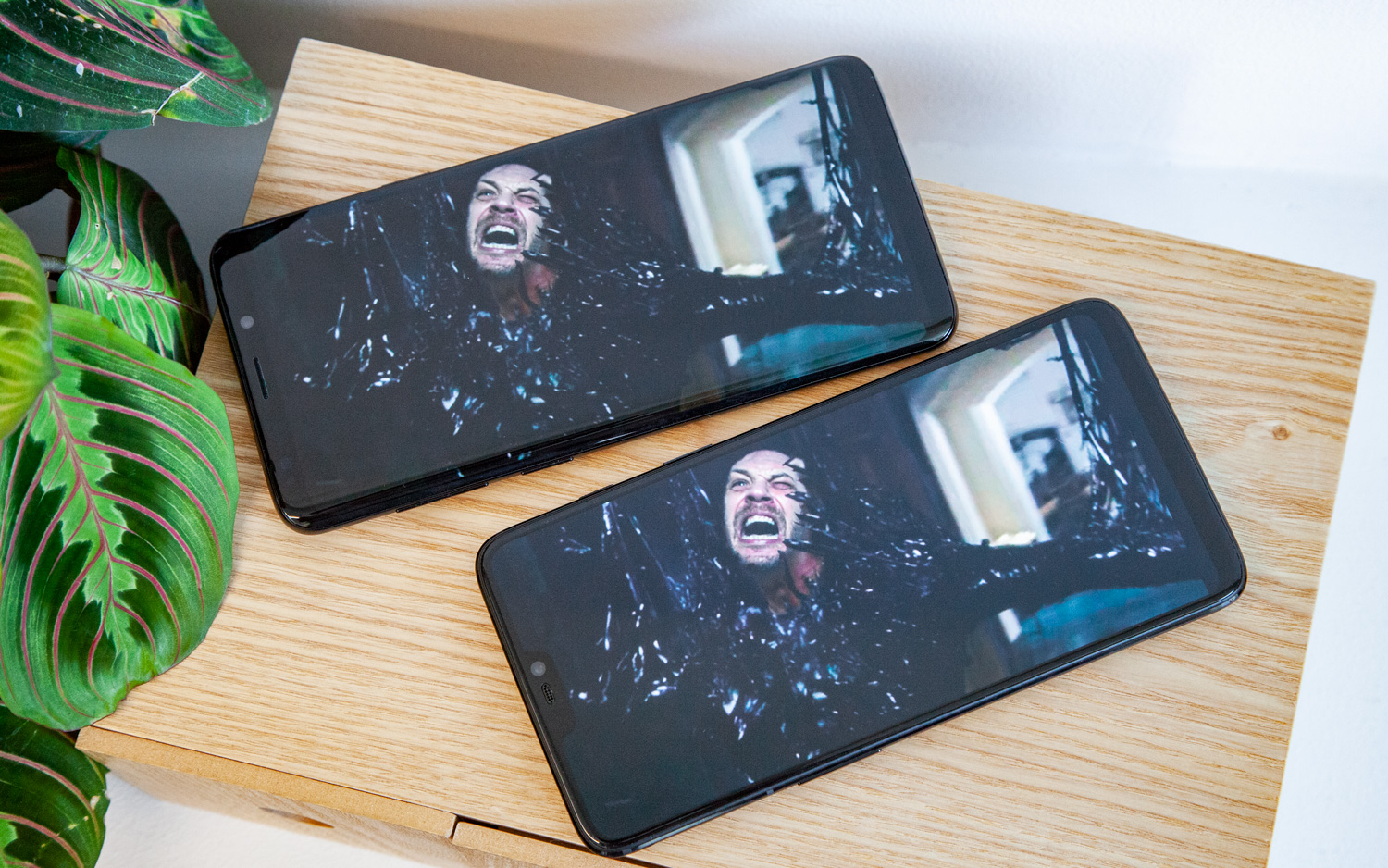
The 6.2-inch screen in the Galaxy S9+ is not only smaller than the OnePlus 6's 6.28-inch panel, but sharper as well — and that translates to a higher pixel density. The display in the Galaxy S9+ has a resolution of 2960 x 1440 and about 529 pixels per inch. The OnePlus 6, which sports a 2280 x 1080 resolution, has only 409 pixels per inch. That's not a massive discrepancy, but it is easier to notice some jaggedness in text and graphics on OnePlus' handset if you look really closely, compared to the crystal clear Galaxy S9+.
In terms of peak brightness, Samsung's device topped out at 603 nits, while the OnePlus 6 came in not too far behind, at 574 nits. The two phones also exhibited a similarly wide spectrum of hues in color-gamut testing: The Galaxy S9+ represented 230 percent of the sRGB space, and the OnePlus 6 managed 240 percent.
These displays are the best you'll find in any modern smartphone and come with an assortment of options to customize their presentation to your liking. But more pixels help Samsung's own device edge out its competitor, even if the two phones use screens from the same source.
Winner: Galaxy S9+
Camera
For the OnePlus 6, OnePlus has added optical image stabilization and increased the size of the image sensor behind the phone's primary 16-megapixel lens. That shooter is accompanied by a 20-megapixel camera with the same f/1.7 aperture and wide-angle field of view as the main one.
The Galaxy S9+ is the first in the Galaxy S lineup to receive a pair of cameras on the back, inheriting the technology that Samsung employed last year on the Galaxy Note 8. However, some improvements have been made to make the S9's photography even better than its predecessors.
For one, the main 12-megapixel lens now automatically varies between an f/1.5 and f/2.4 aperture depending on the requirements of the scene. Combined with that wide aperture, the S9's redesigned, memory-stacked image sensor is designed to let in nearly 30 percent more light than last year's S8.
If you're imagining this would be a boon for low-light photography, you'd be right. Inside our studio with all the lights turned off, the S9+ delivered a surprisingly bright, clean still-life image of a timer and plant on a desk. The OnePlus 6 turned in a shot that compares favorably to most other phones but is considerably darker than Samsung's effort. The wall, plants and most of the times are completely shrouded in darkness by comparison.
Outdoors, the Galaxy S9's advantage wasn't quite as pronounced, though Samsung's device still cruised to a win with this expertly balanced image taken on the grounds of New York's Bryant Park. The OnePlus 6's HDR mode definitely helped illuminate some darker regions but resulted in the unwanted side effect of a washed-out haziness permeating the whole frame. The Galaxy S9+ steered clear of that issue, though it is hard to ignore the lens flare cutting across the middle.
The Galaxy S9's secondary telephoto lens really came in handy when I used the phone's 2x optical zoom to cut in more closely on a statue. The OnePlus 6 lacks such a lens, so it has to rely on digital zoom to compensate, and the results are, well, predictably fuzzy compared to true optical zoom.
Finally, I snapped a pair of portraits of my colleague Jorge to find out which phone was better at handling shallow depth-of-field bokeh. The OnePlus 6 couldn't rein in the highlights from the window and lights quite as well as the S9+ could, but then, at least, it didn't give Jorge's skin the texture of an alien's. Something appears eerily blurry and out of focus about the Galaxy S9's portrait, almost like a face-smoothing filter was applied, even though it hadn't been.
The OnePlus 6's cameras are fine compared to similarly priced handsets, but it simply can't compete with the best flagship imaging tech out there. And the Galaxy S9 ranks among that premium class, especially with its improved low-light performance.
Winner: Galaxy S9+
Performance
There's no difference between the Qualcomm Snapdragon 845 processor powering the OnePlus 6 and the one in the Galaxy S9+. However, benchmarks do indicate a slight gap in performance.
That's likely due to the 8GB of RAM in our $579 OnePlus 6 test unit, which is 2GB more than what Galaxy S9+ owners get. It's only fair to acknowledge that there is also a $529 variant of the OnePlus 6 with 6GB of RAM, which would probably have posted results closer to those of the S9+.
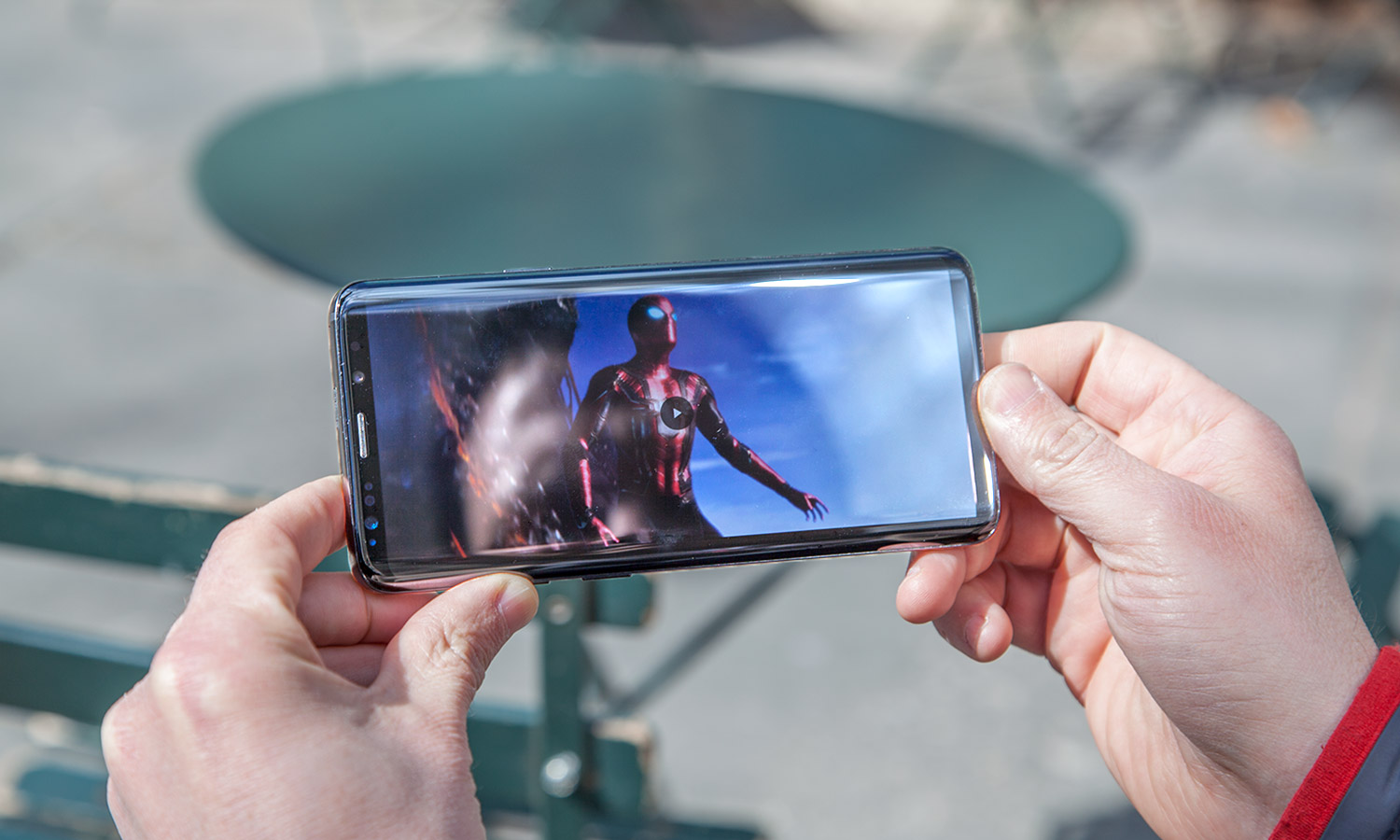
In all our smartphone testing, no device has been able to come anywhere close to the iPhone X's Geekbench 4 score of 10,357. However, the 8GB OnePlus 6 has fared the best. Its 9,098 score outperformed the Galaxy S9+, which got 8,295.
OnePlus' device also toppled Samsung's in 3DMark's Sling Shot Extreme OpenGL ES 3.1 graphics test, posting a score of 5,124, compared to the Galaxy S9+'s 4,634.
In other words, the OnePlus 6 is simply the most powerful Android phone money can buy right now. And that's quite a feat when you consider that the 8GB version costs more than $250 less than the cheapest Galaxy S9+.
Winner: OnePlus 6
Battery
Do you want longer battery life or a phone that charges faster? That's a choice you'll have to make in deciding between the Galaxy S9+ and OnePlus 6.

The Galaxy S9+ lasted for 10 hours and 59 minutes in our battery test, in which websites are streamed continuously until the device shuts down. The OnePlus 6 managed 10 hours and 33 minutes, which isn't significantly worse, but does reflect that the OnePlus 6's 3,300-mAh battery is smaller than the 3,500-mAh pack in the Galaxy S9+.
When it comes to fast charging, though, the OnePlus 6 outpaces everything else on the market. OnePlus' proprietary Dash Charge standard helped the device reach 60 percent in 30 minutes and 93 percent in an hour. That's faster than the Galaxy S9+, which made it to 35 percent and 74 percent in the same amounts of time.
Over the course of a day, we expect the Galaxy S9+ to last just a little bit longer than the OnePlus 6, though we also expect it to take longer to top up. For that reason, this round ends in a wash.
Winner: Tie
Software and Special Features
The OnePlus 6 and Galaxy S9+ take very different approaches to Android, but the two phones also run different versions out of the box. All of OnePlus' latest phones are on release 8.1 of Android Oreo, while the Galaxy S9 remains on 8.0, with the addition of the Samsung Experience interface over the top of everything.
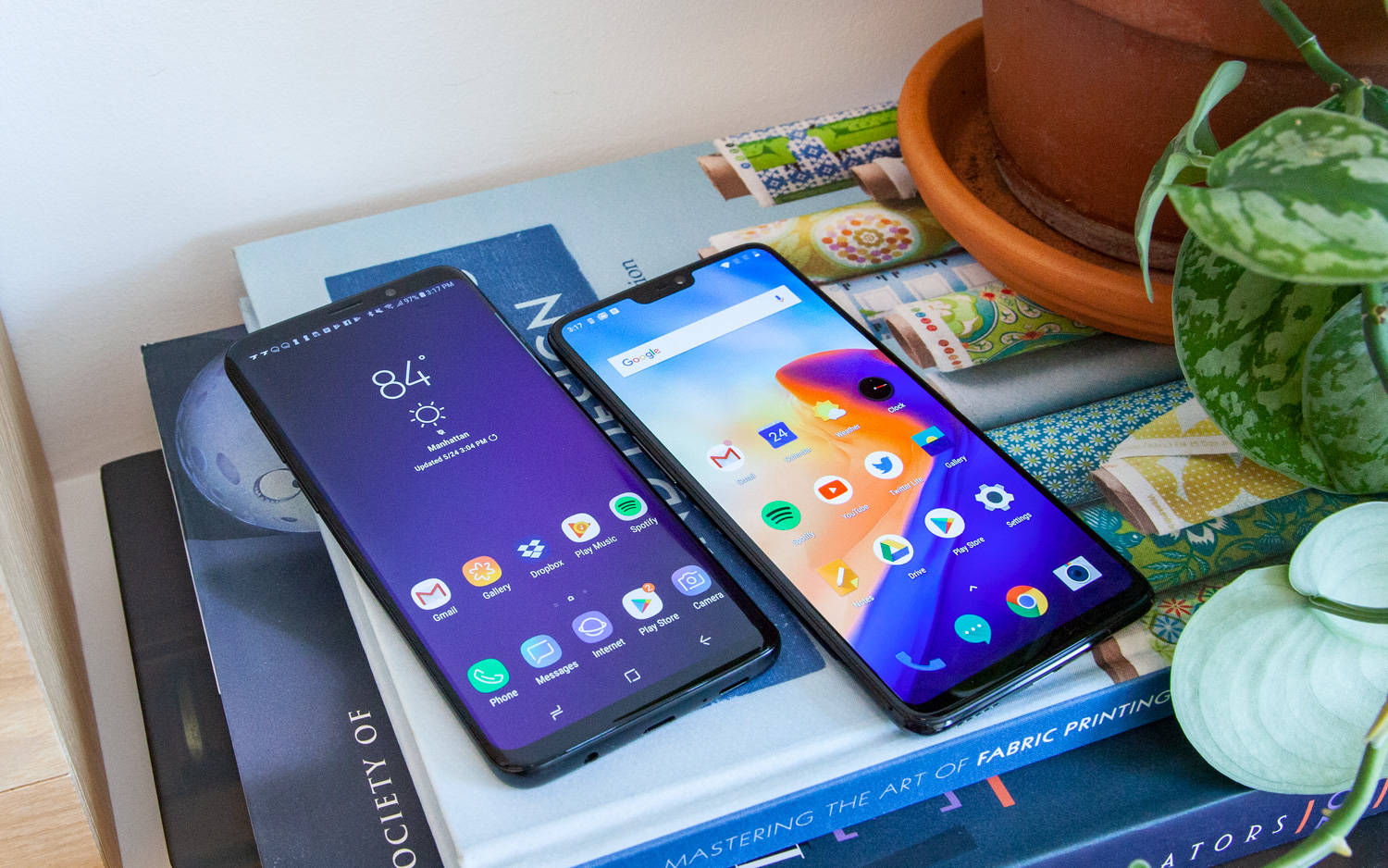
OnePlus' Oxygen OS is a departure from stock Android in its own right, though it's much closer to vanilla than Samsung's skin. The main changes with OnePlus' software pertain to additional features, like faster 2D Face Unlock, a mode which can limit notifications and prioritize system resources for gaming, and even new gesture controls.
These controls are quite different from those you'd encounter in the Android P beta, as they don't occupy any screen real estate and work entirely through swipes up from the bottom. But they're simple and intuitive, just like those on the iPhone X. The best part is, if you'd rather not use gesture controls, you don't have to — they're not even on by default.
In contrast, the Galaxy S9+ feels totally separate from the Android status quo. There's the Edge Panel, a persistent slide-out menu that can store things like notifications and screen-sharing tools, as well as Samsung's Intelligent Scan unlocking tech that combines iris scanning with facial recognition. The Galaxy S9+ has its own virtual assistant (Bixby) and its own payment platform (Samsung Pay) that don’t replace but rather supplement Google's own. Samsung has even taken on Apple's Animoji with AR Emoji — 3D figures that look like you, mimic your movements and admittedly look downright creepy while doing it.
Some of Samsung's additions, like Bixby Vision, are legitimately useful. Bixby Vision functions similarly to Google Lens and operates through the camera app. With Bixby Vision, you can translate words that the camera sees, pull up nutritional facts for foods and even try on some makeup from vendors like Sephora. Business users will also appreciate Samsung's revised DeX Pad, which turns the Galaxy S9+ into a makeshift desktop computer that can be connected to a monitor, mouse and keyboard.
But, by and large, the user experience on the Galaxy S9+ is messy, convoluted and wrought with an overwhelming number of gimmicks that you'll probably ignore. It's simply too busy, not to mention outdated — and history suggests Samsung won't update the Galaxy S9+ to Android P as quickly as it ought to. On the other hand, the OnePlus 6 is one of the first devices to receive the Android P beta, which bodes well for a timely full release.
Winner: OnePlus 6
Price and Availability
The OnePlus 6 starts at just $529, which is $30 more than the outgoing OnePlus 5T but still leagues cheaper than competing flagships. For that price, you get 6GB of RAM and 64GB of storage, though OnePlus also offers an 8GB/128GB model for $579 and an 8GB/256GB one for $629.
The phone comes in shiny Mirror Black or matte-like Midnight Black, as well as a limited-edition Silk White colorway arriving in June. OnePlus' phone is compatible with only GSM networks, meaning Verizon and Sprint subscribers can't use it.
The Galaxy S9+ is widely available at all four major carriers and compatible with any network, but it starts at $839. (Prices vary between different retailers and carriers, though — a variance you won't see with OnePlus, because it's the only place you can get the OnePlus 6.) The base S9+ model offers 6GB of RAM and 64GB of storage. Samsung recently made 128GB and 256GB variants available for $889 and $959, but the built-in microSD slot means you can easily expand storage at any time, even if you buy a lower-capacity version.
The Galaxy S9+ comes in Lilac Purple, Coral Blue and Midnight Black (not to be confused with OnePlus' version of Midnight Black, which isn't as glossy as Samsung's).
The OnePlus 6's price makes it a steal, though the lack of support on all networks means this phone simply won't be a realistic choice for half the of U.S. wireless users.
Winner: OnePlus 6
Overall Winner: Galaxy S9
| Phone | OnePlus 6 | Galaxy S9+ |
| Design (10) | 7 | 9 |
| Display (15) | 14 | 15 |
| Cameras (20) | 14 | 18 |
| Performance (10) | 9 | 8 |
| Battery and Charging (20) | 16 | 16 |
| Software and Special Features (10) | 9 | 7 |
| Value and Availability (15) | 13 | 10 |
| Overall (100) | 82 | 83 |
This face-off couldn't have ended any closer, which speaks to the quality of both devices. These are some of the best smartphones on the market today, but ultimately, the Galaxy S9+ wins because it's the better product overall.
OnePlus should be commended for taking most of what people look for in a flagship handset and rolling it into a package that costs $300 less than Samsung's big-screen, dual-camera offering. But if you can afford the Galaxy S9+, you'll appreciate that it makes fewer compromises. It has wireless charging, water resistance and a design that's easier to hold, with dual cameras that are better for portraits and low-light photography.
Those who are really concerned with getting the most for their money won't be disappointed with OnePlus' latest. But for those who want the best Android phone on the market today, the Galaxy S9+ is the answer.
Credits: Tom's Guide
Adam Ismail is a staff writer at Jalopnik and previously worked on Tom's Guide covering smartphones, car tech and gaming. His love for all things mobile began with the original Motorola Droid; since then he’s owned a variety of Android and iOS-powered handsets, refusing to stay loyal to one platform. His work has also appeared on Digital Trends and GTPlanet. When he’s not fiddling with the latest devices, he’s at an indie pop show, recording a podcast or playing Sega Dreamcast.
-
ridhimasane samsung s9 is flagshil smartphone from samsung with some top notch specifications and features and which definitely wins over oneplus 6 which is latest smartphone from the oneplus which has huge popularity among buyers and it comes to reasonable price as compared to samsung galaxy s9 .Reply -
Etherael I feel the two are very close, price point is a bigger factor for most, also there is less bloatware with One+6, thus another reason for performance enhancement. To me IPX ratings are great, but OnePlus is water resistant enough to withstand, short of dropping it in the ocean. Just doesn't have an official rating. My money goes to One+ simply on ability to customize it far more than the Sansung and the 300 dollar less price tag.Reply

